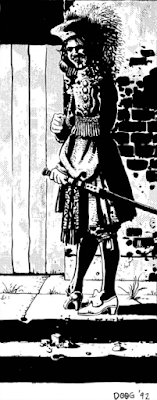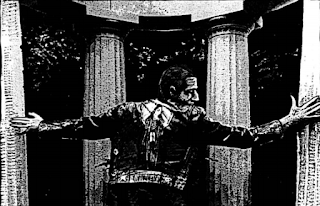 |
| White Wolf |
The Storytellers Handbook
White Wolf Game Studio
Designed by Andrew Greenberg, Graeme Davis, Dustin Browder, Dan Greenberg, Steve Crow, Frank Frey, Danny Landers, Rob Hatch, Mark Rein Hagen, Stewart Wieck, Sam Chupp, and Travis Williams
The 90s mainstay roleplaying game Vampire: The Masquerade turns 30 this year. In that time the game and its designers did much to push the medium forward, both in terms of representation and popularizing a more narrative driven focus. Admittedly in recent years, Vampire has become something of a wilted rose and a particularly thorny one at that.
Even so, one thing hasn't changed over the decades. Would-be players and storytellers look to the heavens and ask "Well, how do you actually run a Vampire: the Masquerade campaign?" Historically, the books have done an excellent job establishing a rich setting of elaborate political systems and shifting mythologies, capped off by a millennia long struggle between individual vampires and the factions they represent.
Unfortunately, there's only so many pages in a rulebook and so it's often been vague how to bring any of that to the table, at least in a way players can properly engage with. Game masters, or in White Wolf's preferred terminology Storytellers, were largely left to figure that out on their own.
Published at the tailed of Vampire's first edition, The Storytellers Handbook came to the rescue. Released in 1992, this 151 page book intended to show Storytellers not only how to improve their Vampire campaign but more broadly how to run RPGs as fleshed out stories rather than scaled up wargames.
The Handbook is just shy of three decades old, so the book was obviously meant for a very different version of Vampire. Not everything has stood the test of time (or was very good to begin with) but there's some sound advice for storytellers of all stripes.
Back to Basics
The first half of The Storytellers Handbook is almost exclusively narrative in focus. It alternates between being broad and specific, sometimes on the same page. Sure, it teaches storytellers how to use the elaborate system of favors that holds the Camarilla together and how to handle quests for Golconda. But that's weighed with more fundamental advice, on how to give a story a real narrative arc, balance the tone, and the like.
It also gives advice for different styles of play, settings, and genres. One of the major takeaways from The Storytellers Handbook is that there isn't a single way to tell a story and you should approach Vampire with the same mindset. It encourages you to keep your vision broad and opt for the different and unexpected. Vampire was already a major departure from the endlessly-plodding-through-dungeons style of gaming. But the designers of this book didn't want to replace one rigid paradigm with a different but equally limited one.
 |
| White Wolf |
Beyond advice specific to Vampire's setting, there's a good deal of more general tips. Namely on how to adapt the art of storytelling to the challenging medium of roleplaying games. There isn't another art form where the audience has such a strong say over the story and The Storytellers Handbook takes that into account.
Like a lot of early White Wolf content, there's a deliberate effort to minimize the game aspect in favor of the story the table wants to tell. That approach isn't for everyone but it's how I run my RPGs and The Storytellers Handbook makes a good case for it. The key takeaway us your story belongs to the players too. Storytellers shouldn't be tyrants and you shouldn't be distributing "scripts," with players are goaded down a narrow corridor. The book advises to come up with possible routes rather than definitive paths, as players will always do something unexpected. That's something to be embraced not fought against or begrudgingly accepted.
This is very much an aid for playing Vampire but even so there's still sound pointers on GMing, regardless of the system you're using. I wouldn't say it's enough to justify the purchase for someone who never intends to play out the Camarilla and Anarchs' clashes at their table. But if you do get The Storytellers Handbook in preparation to run Vampire, you'll find its usefulness extends well beyond the World of Darkness.
Moving Parts
The Storytellers Handbook goes beyond just offering advice though. Worksheets for fleshing out settings and chronicles are provided, handy resources that remind me of Creative Writing classes I've taken. The short segment detailing Live-Action Roleplay is amusing, especially considering how what was given three pages here would later become an integral part of Vampire's identity.
The latter third of the book is mostly mechanical in focus. The adversary section provides profiles for villains in the players' campaigns, with advice on how to work them into the story as dynamic elements and not just Things To Kill. Creatures from the other game lines make appearances, though little is provided to work through the difference in power and even mythology between Vampires and their supernatural relatives.
 |
| White Wolf |
Bringing in werewolves has always been an established part of Vampire, as even this early on the looming threat of "Lupines" was a way to encourage vampires to stay citybound. Other creatures don't have the same justification though.
Even if World of Darkness ostensibly shares a setting between the different games, as far as I can tell mixing them together never ends particularly well. Still, it's nice to be provided the option.
Vampire the Masquerade 1st edition isn't a particularly popular version of the game. I'd say that's due to clunky mechanics and some weirder setting elements. Barring a few stretches that doesn't really impact the usefulness of The Storytellers Handbook, but it does render the final chapter of the book, "The Ways," unhelpful. Admittedly even if I were to run a 1st edition game, I don't think I'd find it any more valuable. The slew of expanded rules for firearms and a somewhat random slew of mechanics for things like interrogation and hedge magic, just strikes me as unnecessary complexity.
More interesting, if a bit uncomfortable, are expanded rules for how difficult it is to hunt people in cities, modified depending on whether the approach is more "romantic" or direct. It carries a lot of unfortunate implications but ones fundamental to the concept of vampires. Considering the Golconda section makes it clear players should have something to regret before seeking a cure for vampirism, it makes sense to have.
Into the Night
With the broad range of topics covered, I'm impressed that The Storytellers Handbook avoids feeling like a bunch of articles taken from the long dormant Vampire Magazine. There's a consistent throughline and as much as it encourages thinking outside the box, there's a consistent ethos. Enough is given to capture the "standard" Vampire tone while still reminding you not to get trapped in it.
 |
| White Wolf |
There's a wide range of art and not all of it is particularly good but the range of styles fits the overall message of The Storytellers Handbook well enough- there's no wrong way to play Vampire.
Straight from the Horse's Mouth
Before giving way to reference charts that annoyingly lack page numbers, The Storytellers Handbook ends with a series of essays from a number of the designers. Vampire creator Mark Rein Hagen's recollection of his young RPG attempts being foiled by uncooperative players was very relatable and contains insights that make it worth seeking out by any serious game master.
The quality varies from there. Rob Hatch's "The Sound of Music: Songs for a Gothic Punk World," unsurprisingly reveals that developer Vampire chronicles were played to lots of Joy Division. Travis Lamar Williams idea of having players simply translate themselves as characters strikes me as being all at once unimaginative, hard to take seriously, and very likely to end badly.
 |
| White Wolf |
Future clanbook line editor Dan Greenberg's essay takes a very worrying turn as he details the kind of "evil" that should feature in your Vampire story. He argues that widely maligned dictators, namely Hitler and Sadam Hussein, are nothing compared to the broken promises and campaigns of terror waged by Western Superpowers. It's a point I'd agree with if Greenberg didn't frame it as an either/or choice - the former only exists because of the latter.
As ignorant as it might be, it does reveal quite a bit about the Vampire developers' intent for the game (as well as a few of the more objectionable parts of the clanbooks). Vampire: the Masquerade isn't about the obvious evils but rather the quieter ones accepted by most living in developed countries.
The Storytellers Handbook has its unfortunate moments. Settings outside of Europe and North America are given little support beyond being noted as "exotic" alternatives. But that's to be expected from White Wolf, who's attempts at being cutting edge often pushed the boundaries of taste. That's one thing this book won't help you with, navigating the more objectionable parts of Vampire.
Even so, I think this is a valuable book for the prospective Vampire: The Masquerade Storyteller. The Storytellers Handbook provide what's needed to build a more compelling narrative around your group's kindred. Though I'd advise exercise some good judgment along the way.
No comments:
Post a Comment